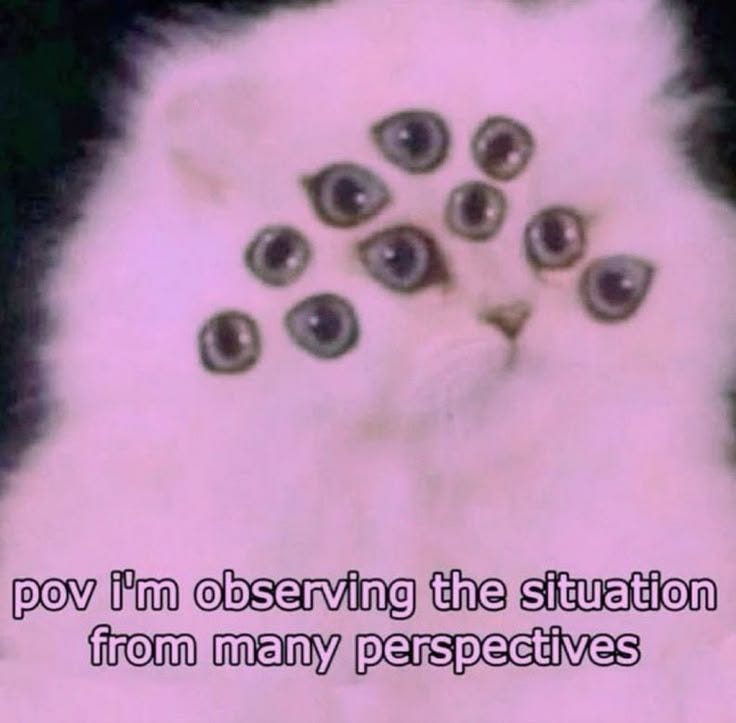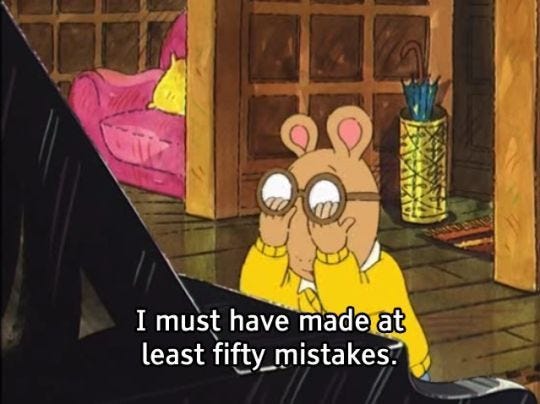The Overthinker’s Guide to Writing Your First Substack
6 steps for perfectionists, procrastinators, and serial idea-hoarders
You want to start a Substack, but you’re stuck.
Because what are you even supposed to write about?
Too many decisions, too much to consider!
Can you write about your business, your latest hyperfixation, aaand tell childhood stories? Of course you can. But you already knew that.
You’re actually hung up on the question: Will people care?
And the answer is no, not at first. Not yet.
To get to the phase where people care, you have to get through the phase where nobody cares. You can’t skip that part.
You have to care.
You have to care.
So if you cared enough to click on this post, it’s time. Let’s write your first Substack.
Step 1: Brain Dump
Take your computer, pad of paper, or voice memo app and go somewhere you can think (coffee shop, kitchen table, office, patio, park).
Put your phone on Do Not Disturb and place it somewhere inconvenient to pick up (zipped in a bag, across the room, in another room, etc.) — completely out of sight.
Now put your pen to the paper, fingers to the keyboard, and let your brain do what it wants.
Your intention is to brain dump about your first Substack post, but don’t try to control what comes out. If a to-do list comes out, let it.
Your job is just to keep your hands moving — no editing, no criticizing, no judging.
Let the subject matter go where it goes. You may be surprised by what comes out.
Your Substack of all places does not have to be niched down, so don’t worry about your posts “fitting” together. Everything will fit together because you wrote it.
After 15 minutes, you may feel done. That’s fine. You did the brain dump, and that’s a win!
If you still have more to say, keep going. When you have momentum, ride it. Don’t question it.
Step 2: Write the Shitty First Draft
Set a timer for one hour, silence your internal editor, and let it rip.
Write with no mind to who’s going to read it or what they’ll think.
Don’t try to be clever. Don’t try to sound smart. Don’t worry about thesaurus.com right now. Just say what you mean.
See if you can find some order in your brain dump — What themes did you notice? Did some kind of structure rise to the surface? Is your point clear?
It’ll feel like you’re all over the place. That’s okay. That’s the point. You can move everything around later. This step is about getting something down.
If you feel stupid, if you feel like your writing is bad, if you feel like there’s no way you’re going to publish this — remember that all great writers start with shitty first drafts.
There’s no way around it, and you shouldn’t try to avoid it.
The shitty first draft is the portal to the decent second draft and the pretty good third draft.
All the SFD has to do is exist.
Once you’re done, ride the momentum if it’s carrying you somewhere.
If you’re done for now, let the SFD rest for a couple of days. The goal is to forget what you wrote before you approach it again.
Psst — Just letting you know that if you have trouble getting yourself to sit down to write, I get it. My
meets every Monday/Saturday and your first week is free, come write your shitty first draft with us!!Step 3: Come Back to It
After you’ve had some distance from your draft, grab your editor’s cap and set a timer for one hour.
Release all attachment to the way your SFD is written, and approach it like someone else’s work — as if you’re editing a peer’s paper in school. Be liberal with the red pen.
Sometimes your work will benefit from restructuring your favorite sentence or scrapping an entire section, and that’s more difficult when you’re emotionally attached.
Don’t be precious about anything. Deleted sections were not written in vain, and nothing is ever wasted.
Read it out loud. Does it flow? Does it make sense? Would you read it if you weren’t the one who wrote it?
Does it drag? Does it need more context? Clarity?
Swap out words, move sentences around, and rewrite the parts that confuse you.
At the end of the hour, evaluate whether you need another editing session, but don’t get stuck here.
The Perpetual Research Phase is quicksand for the creative process — it tricks you into thinking you’re making progress. Moodboarding, ideating, researching… it feels productive, but really, it’s just another way to avoid doing the actual thing.
Even once you’ve started writing, you’re not immune to PRP. It reappears as endless tweaking, refining, and second-guessing. Don’t let your article die in the editing phase.
Remember: you have to care, even if nobody else does right now.
In fact, let that thought be freeing.
If nobody is going to read this yet, then there’s no pressure for it to be perfect.
This first one gets to be for you. It’s safe to move past the editing phase. It’s safe to let your work be read.
Step 4: Add Final Touches
This step is only for people who:
Have a specific target audience in mind
Have experience creating internet content
Have an established personal brand or business
If you’re just finding your voice, skip this step. You don’t have to care about strategy right now. In fact, it’s probably better if you don’t.
But if you do care, which you probably do since you’re reading this, let’s cover the basics.
Title
Put yourself in the shoes of your target audience. If you saw a stranger’s article with this title, would you click? Aim for clear, not clever.
Thumbnail
Would it grab your attention if you saw it on the explore page?
Title and thumbnail are the packaging of your article. Just like YouTube, they determine whether someone clicks.
As you scroll through Substack, take note of the titles and thumbnails that stand out to you — learn from these.
Body
Preview your article on both mobile and desktop. What’s your impression of it as a reader?
Are the paragraphs too long? Would more section headers help? Could it use an image or two? Maybe a gif?
Make it easy for the reader — attention spans are short, so keep that in mind.
This isn’t about dumbing it down. Substack is a great place for long-form content, but if your goal is readership, consider your ideal reader’s experience.
Don’t forget — hitting publish matters more than having the perfect strategy right now.
Respectfully, you have no business worrying about your longterm branding strategy before you’ve posted a few times.
If you’re ready to dive into Substack, but don’t want to lose yourself to a niche, check out Substack School for Creative Overthinkers, our new audio class!
Step 5: Publish
Like any important email, you’ll find all your typos after you hit send.
So if you want to sidestep the endless cycle of proofreading, publish your piece before it feels 100% done.
In four years of writing online, I’ve never published an article without going back later to fix a typo, change a word, or completely rewrite a sentence.
No one is going to see it right away, so the stakes are low.
Click post, then read your published article and make as many changes as you need.
Then take a beat to relish in the “just posted something to the Internet” feeling!
You cared enough to do this for yourself, and that’s not nothing.
Even if no one reads it, it still matters — every single piece you write sharpens your skills and moves you forward.
Each one is worth the time.
Each one has a place.
Each one leads to the next.
Step 6: Keep Going
Even though you made it through your first post, don’t be surprised if your next one feels just as difficult!
It’s probably going to suck all over again.
But you did it once, you can do it twice.
Follow these steps again until your own process reveals itself.
Keep moving on to your next piece until your overall direction becomes clear.
Don’t concern yourself with where it’s going — your only job is to keep publishing.
Ready to take a baby step?
Brainstorm three things you could easily write about and drop them in the comments.
If you’d like personalized help with your Substack, message me on IG to learn more about my 1:1 sessions













thank you thank you for your thoughtfulness!!!! this is amazing advice. not starting a substack yet but will be remembering this for my student newspaper articles 😁😁
Thank you for these tips! Definitely going to bookmark this post :)